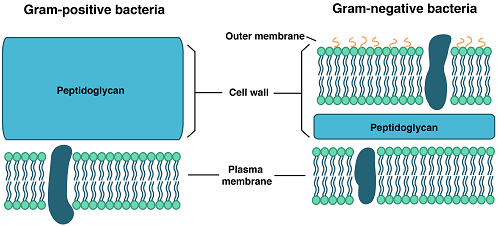Cell wall - Introduction, History, Fungal cell wall, Bacterial cell wall
Introduction to Cell wall
The cell wall is a structural layer surrounding some cell types. They are found immediately outside the cell membrane and can be tough, flexible, or rigid. It is present in fungi, algae, plants, and prokaryotes but absent in eukaryotes (animals).
Its function is to provide structural support, shape, and function to the cell as well as work as a selective barrier. Another major function is to withstand osmotic pressure and mechanical stress.
History of Cell wall
Robert Hooke in 1665 was the first person to obverse, describe, and coin the term. Karl Rudolphi and J.H.F. Link jointly proved in 1804 that each cell had independent cell walls.
Fungal Cell wall
In most true fungi, the cell wall consists largely of chitin and other polysaccharides but lacks cellulose in their cell walls. The components of the cell wall contain – chitin, glucans, and proteins. They lack cellulose, which is a common component in plant cell walls.
Chitin
Consists mainly of unbranched chains of β-(1,4)-linked-N-Acetylglucosamine (in the phylum Ascomycota and Basidiomycota) or poly-β-(1,4)-linked-N-Acetylglucosamine (in phylum Zygomycota).
It is synthesized and extruded at the plasma membrane.
Glucans
They are glucose polymers whose function is to cross-link chitin or chitosan polymers.
It links glucose molecules via β-(1,3)- or β-(1,6)- bonds.
Provides rigidity to the cell walls.
Proteins
They are enzymes that are necessary for cell wall synthesis and lysis.
These structural proteins are glycosylated and contain mannose i.e. also mannoproteins or mannans.

Image: Bacterial Cell Wall
Bacterial Cell wall
The cell membrane of prokaryotic cells such as bacterial cells is protected by the bacterial cell wall. It is composed of peptidoglycan and is formed when polysaccharide chains are cross-linked by unusual peptides containing D-amino acids.
Based on the cell wall composition of bacteria, it is divided into two types - gram-positive bacteria and gram-negative bacteria. The differentiation is done by a commonly used procedure called Gram staining.
Gram-negative bacteria have thin cell walls. It has a few layers of peptidoglycan surrounded by a second lipid membrane containing lipopolysaccharides and lipoproteins.
Gram-negative bacteria have a thick cell wall consisting of many layers of peptidoglycan and teichoic acids.
The difference in bacterial cell walls can be exploited in antibiotic susceptibility. Gram-negative bacteria are killed by the use of beta-lactam antibiotics (e.g. penicillin, cephalosporin) while gram-positive remain unaffected.
Similarly, glycopeptide antibiotics (e.g. vancomycin, teicoplanin, telavancin) are effective against gram-positive pathogens but not gram-negative ones.